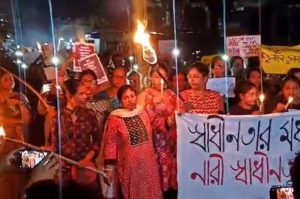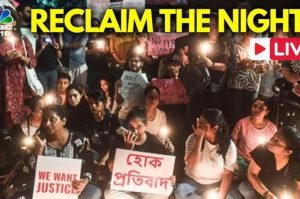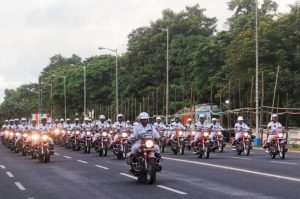Kolkata on High Alert as Protest — The heart of West Bengal is beating faster tonight. As the humid August air settles over the city, the streets are bracing for a rare and high-stakes convergence: the first anniversary of the “Reclaim the Night” protest and the nation’s 79th Independence Day celebrations.
In the hours ahead, Kolkata will witness two very different gatherings — one a solemn, spirited march demanding justice and safety for women, the other a joyous celebration of the country’s freedom. The city’s police force, caught between the demands of security and the rights of citizens, is attempting a delicate balancing act.

An Unprecedented Challenge for Law Enforcement
At Lalbazar, the nerve centre of Kolkata Police, the atmosphere is tense yet methodical. A massive operations chart sprawls across the wall, mapping protest hotspots, parade routes, traffic diversions, and security cordons. Senior officers in khaki pore over updates from the field, their walkie-talkies crackling with instructions.


Nearly 5,000 police personnel will be deployed across the city — the largest single-day deployment since the 2019 general elections. Of them, around 2,000 officers are being stationed at Red Road, where the official Independence Day parade will unfold at dawn.
Security measures include:
- 20 security sectors, each led by a deputy commissioner, covering both the parade zone and protest routes.
- Temporary police control booths set up along major arteries such as Park Street, Esplanade, and Gariahat.
- Drone surveillance over Red Road and key protest gathering points.
- CCTV coverage of a 2 km radius surrounding Maidan, Jadavpur, and Salt Lake.
- Quick Reaction Teams (QRTs) stationed at Metro hubs like Rabindra Sadan and Central.
The Commissioner of Police, briefing the media earlier today, stressed a zero-provocation policy:
“We will ensure that the public’s right to peaceful assembly is protected, but any attempt to disturb law and order will be dealt with swiftly and proportionately.”
The “Reclaim the Night” Movement: From Grief to Resistance
The “Reclaim the Night” campaign emerged last year in the wake of a horrific crime — the rape and murder of a young postgraduate doctor at RG Kar Medical College. The case shook the state, sparking outrage not only for the brutality of the act but for perceived lapses in safety measures for women in the workplace.
Over the months that followed, the movement grew beyond the medical fraternity. Students, civil rights activists, women’s groups, and ordinary citizens began marching through the streets, often late into the night, carrying placards and chanting slogans: “We will walk without fear”, “Safety is our right”, and “Justice delayed is justice denied.”
The protests were not without confrontation. In August 2024, clashes broke out between marchers and police outside RG Kar’s gates, leading to injuries on both sides. Footage of police dragging away women protestors went viral, sparking debates about gender, power, and the limits of policing.
External background: RG Kar Medical College incident – BBC News


Why This Year’s Protest Is Different
Unlike last year’s scattered rallies, this year’s observance has been meticulously planned. The primary march is expected to start at Rabindra Sadan at 10:30 pm and wind through AJC Bose Road, Esplanade, and College Street. Parallel marches are planned in Jadavpur, Dum Dum, and Salt Lake, all converging into symbolic “safety circles” — public gatherings where women and allies occupy key intersections after dark.
Social media has amplified the call. Instagram stories, X (formerly Twitter) threads, and WhatsApp chains are urging people to join “in any capacity — walk, hold a candle, or even just be present.”
Independence Day Parade: A City Tradition
Meanwhile, a few kilometres away, Red Road is being transformed into a patriotic stage. Rows of tricolour flags line the avenue. Grandstands are being readied for schoolchildren, military veterans, and VIP guests.
The parade has been a fixture of Kolkata’s Independence Day since 1948. It begins with the ceremonial hoisting of the national flag by the Chief Minister, followed by a military guard of honour, cultural performances, and tableaux representing different districts of Bengal.
This year’s parade will also pay tribute to the 100th birth anniversary of Satyajit Ray, featuring a cultural segment inspired by his films. Schoolchildren in bright costumes have been rehearsing for weeks under the watchful eye of their teachers — though the rehearsals have not been without incident.
Health Scare During Preparations
On August 10, during a mid-morning drill on Red Road, 15 schoolchildren and 3 police officers collapsed due to heat exhaustion. Kolkata’s humidity, combined with temperatures hovering at 35°C, pushed the city’s heat index into the danger zone.
Emergency medical teams rushed to the spot, providing oral rehydration and shifting the most affected to SSKM Hospital. While all recovered, the episode has prompted authorities to:
- Shift some rehearsals to early mornings.
- Install shaded rest areas for parade participants.
- Set up first-aid booths and mobile ambulances along the route.
Further reading: Heat and humidity impact Kolkata parade rehearsals – Times of India
A City of Protests: Historical Context
Kolkata is no stranger to managing parallel narratives of dissent and celebration. The city has a rich tradition of political and social activism, dating back to the anti-colonial movements of the early 20th century. From the Quit India Movement to the Naxalite uprisings, and from labour strikes to climate marches, Kolkata’s streets have been a constant theatre of civic action.
“The essence of Kolkata is its ability to hold celebration and resistance in the same breath,”
says historian Dr. Ranjana Banerjee of Jadavpur University.
“Our freedom struggle itself was a protest — so it is fitting that on Independence Day eve, citizens still use the streets to demand justice.”
Reference: Protests in India – Wikipedia
Public Mood: Pride and Vigilance
In neighbourhood tea stalls, the conversations tonight are as varied as the city itself. At a roadside dhaba near Esplanade, 26-year-old Paromita Das says she will attend both the march and the parade:
“My grandfather fought in the independence movement. He used to say that freedom is meaningless without safety. So I will march for my right to walk at night and then I will stand at Red Road to watch the flag go up.”
Others are more cautious. Shopkeeper Harun Sheikh in Park Circus says he will close his store early:
“There will be big crowds. I just hope everything remains peaceful. I have seen how quickly things can turn.”
Kolkata on High Alert as Protest: The Police’s Dilemma
For Kolkata Police, the challenge is not just operational — it is also symbolic. A heavy-handed approach could inflame public opinion, while lax enforcement could risk public safety. This is especially sensitive given the gender-focused nature of the “Reclaim the Night” protest.
A senior officer, speaking off the record, said:
“We have been told clearly — no unnecessary force, no escalation. But we are also accountable if anything happens. It’s a tightrope walk.”
Expert Views on Managing Converging Events
Security analyst Anirban Guha notes that handling simultaneous large gatherings requires “layered intelligence” more than brute manpower.
“You can’t be everywhere at once, so you rely on rapid information flow, mobile units, and crowd psychology management. Kolkata is good at this because the city has decades of experience with political rallies.”
The Hours Ahead
As night falls, the first groups of protestors are expected to gather at Rabindra Sadan. Organisers are urging participants to carry water, avoid confrontation, and keep the marches non-violent. At the same time, on Red Road, final sound checks and stage setups are underway for tomorrow’s parade.
By dawn, Kolkata will shift from protest chants to patriotic songs, from candlelight vigils to the crisp salute of the armed forces.
The question is whether the two spirits — dissent and celebration — can coexist without clashing.
Symbolism That Resonates Beyond Kolkata
Observers note that the events here could set a precedent for other Indian cities. Mumbai, Bengaluru, and Delhi have all seen similar overlaps between political protests and cultural events. How Kolkata handles this moment will be closely watched by civic planners, human rights groups, and security agencies nationwide.
In essence, tonight’s Kolkata is a microcosm of democracy itself — a place where people remember the cost of freedom while fighting to make it complete. Whether on the streets in protest or in the stands for the parade, the city’s citizens are, in their own ways, reclaiming what they believe independence truly means.
Also read: Home | Channel 6 Network – Latest News, Breaking Updates: Politics, Business, Tech & More

